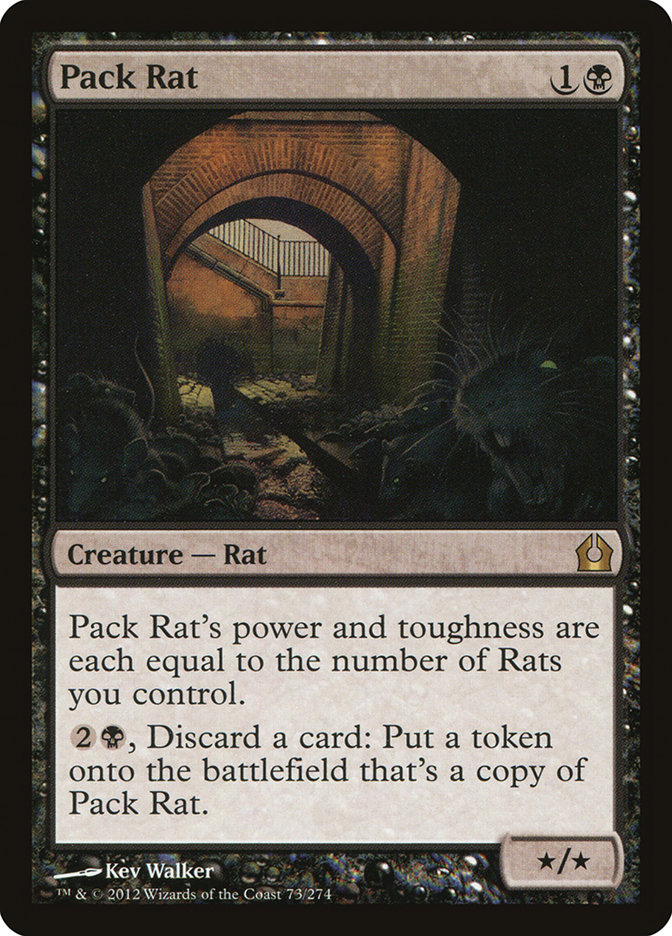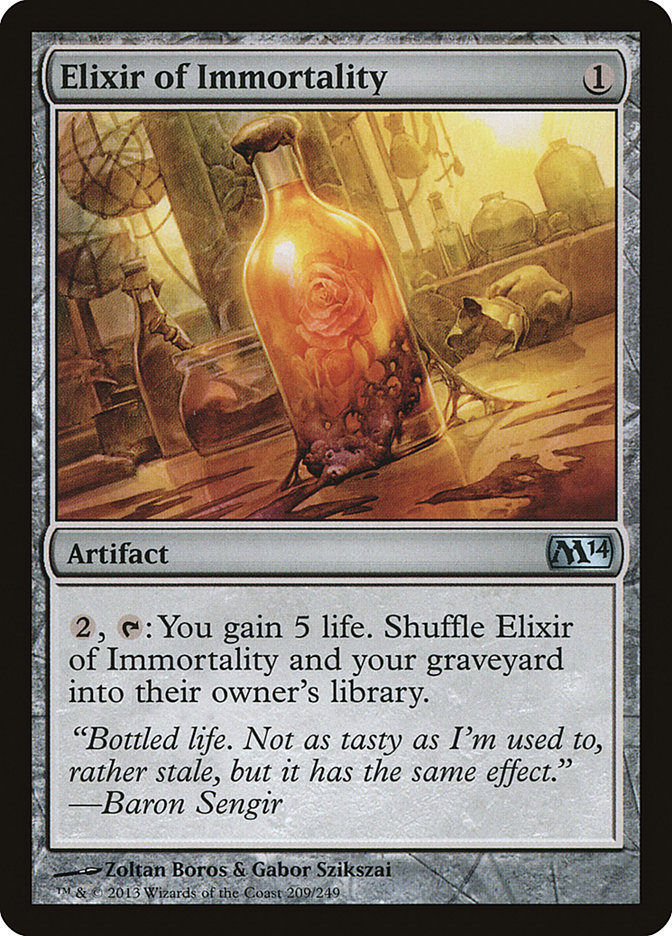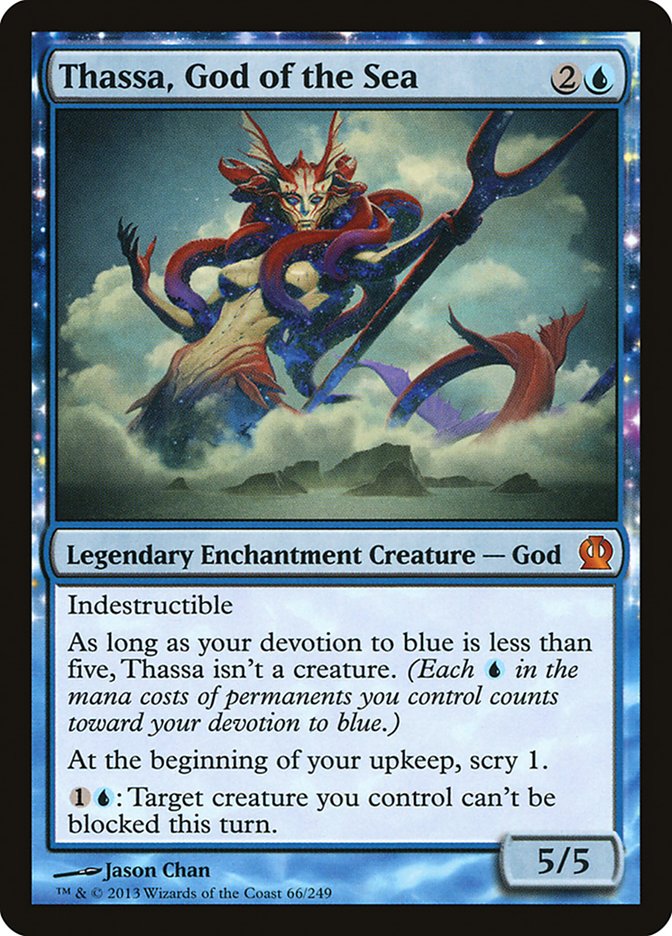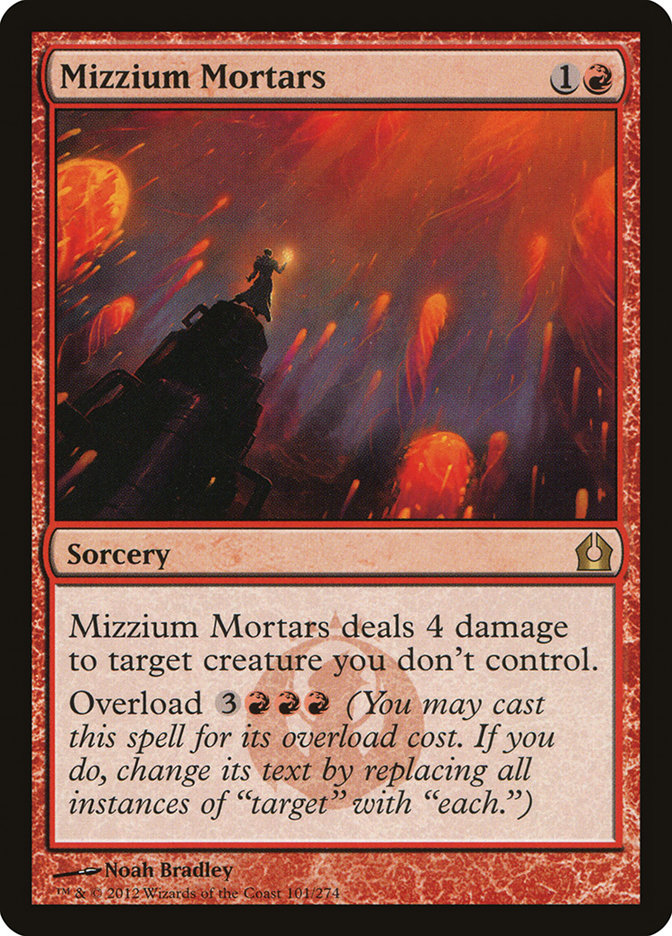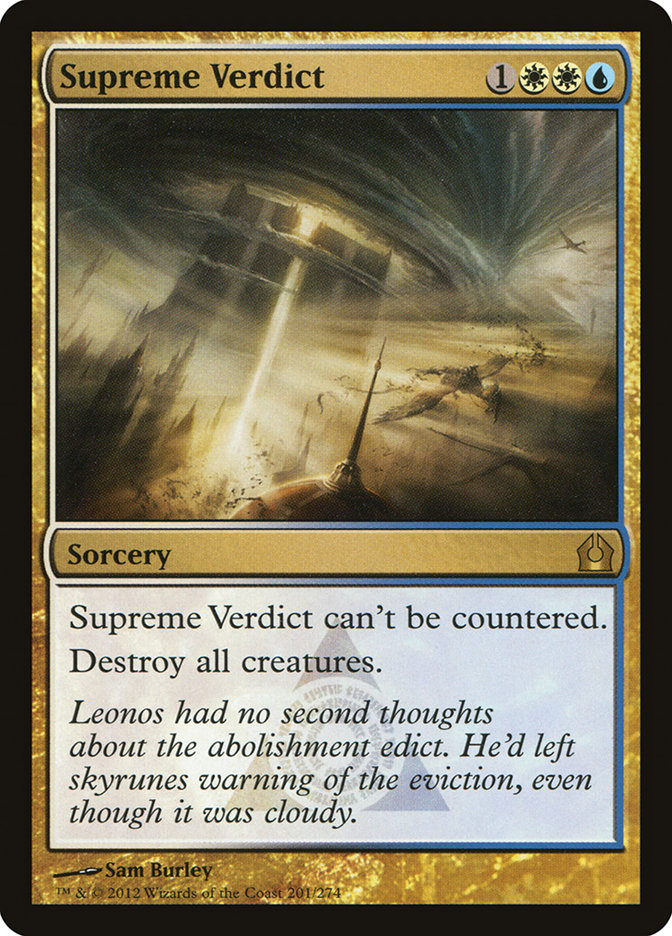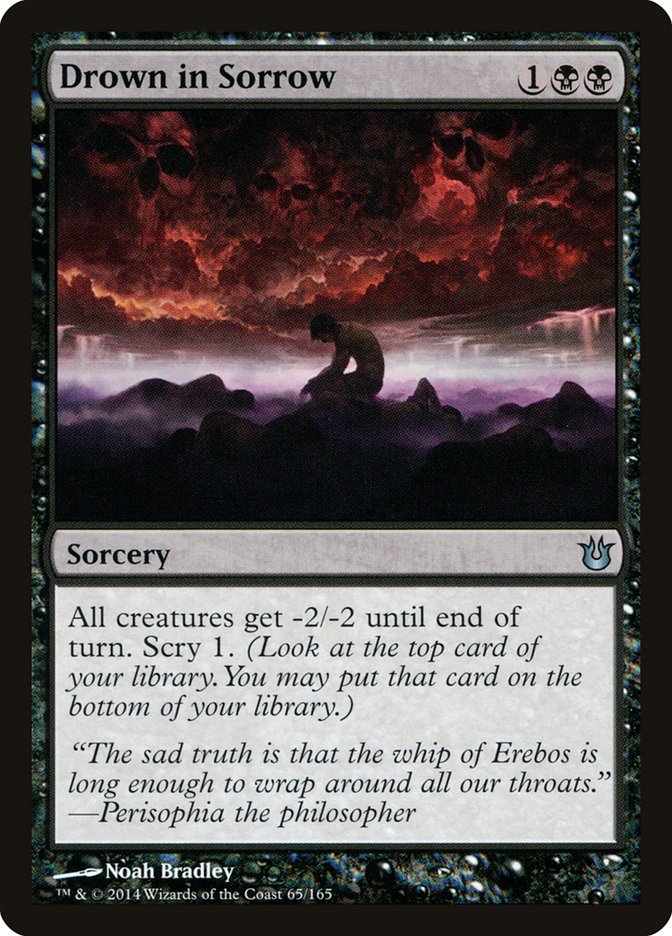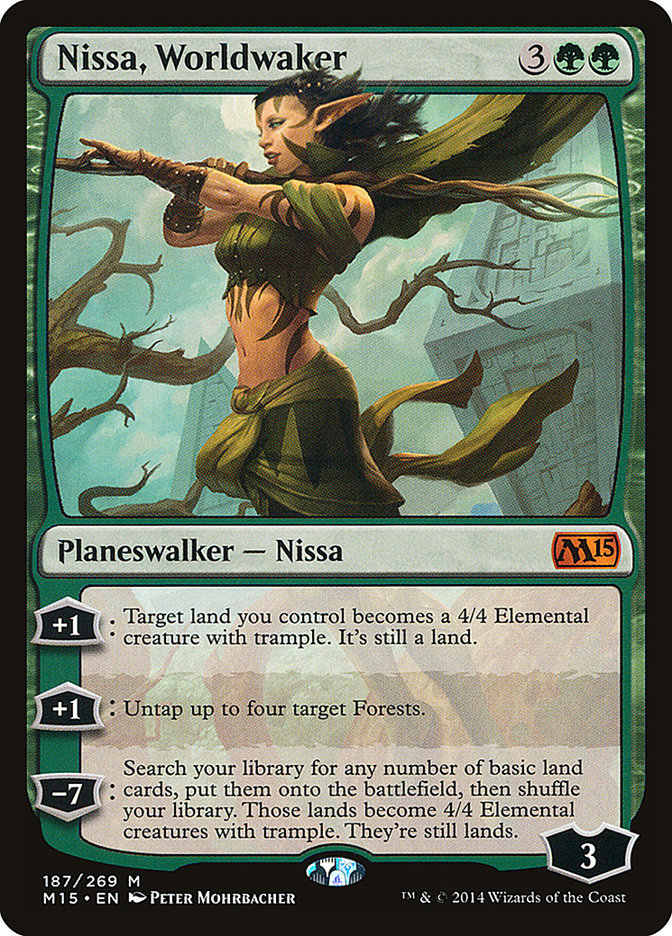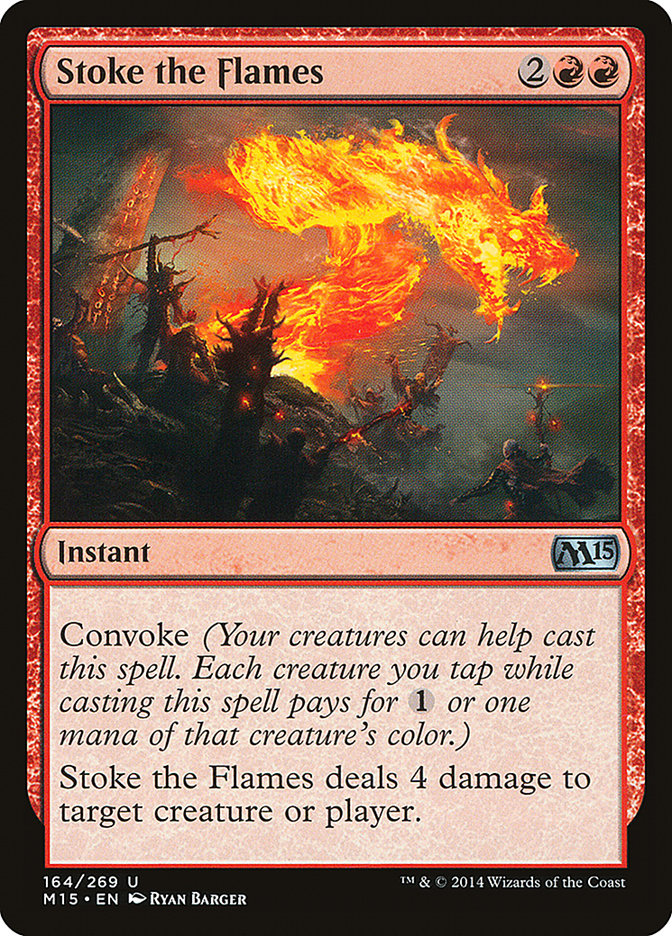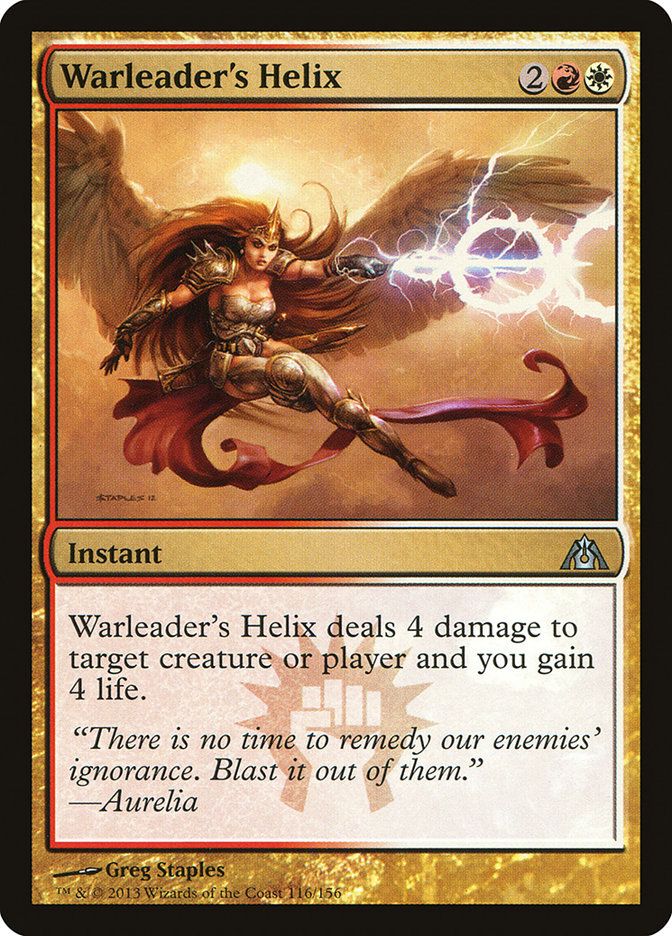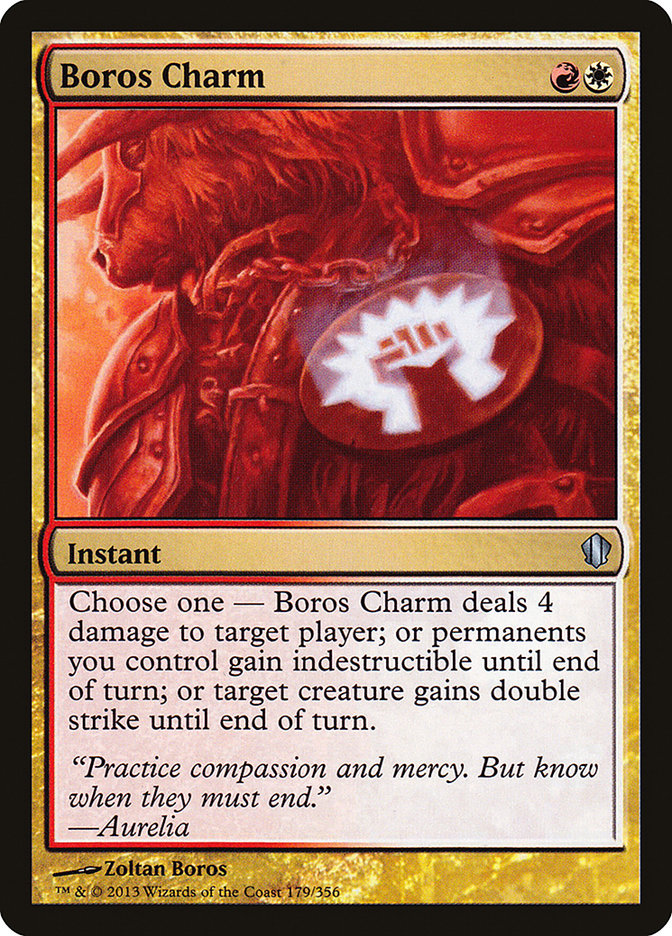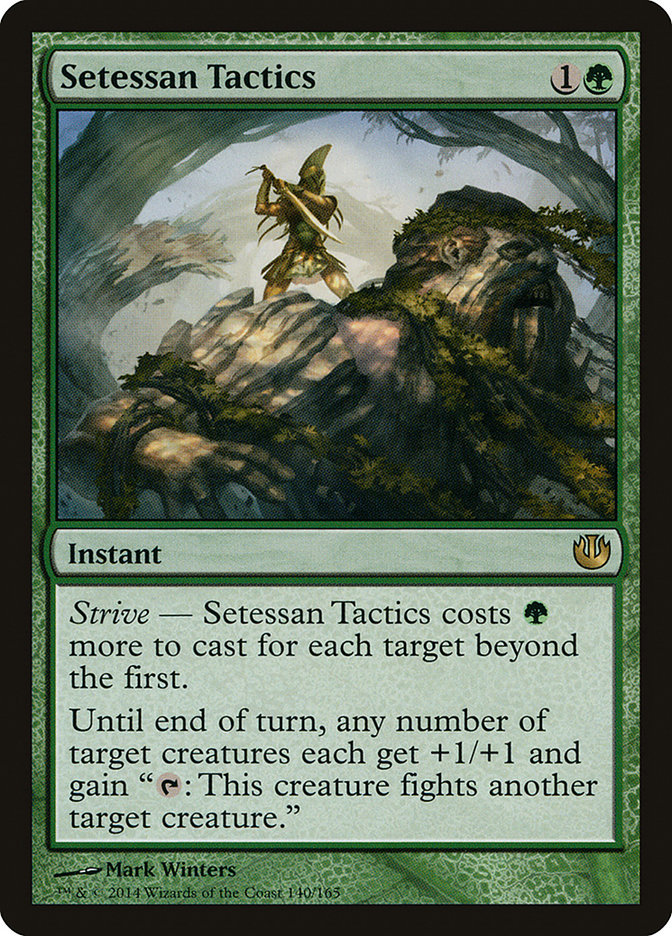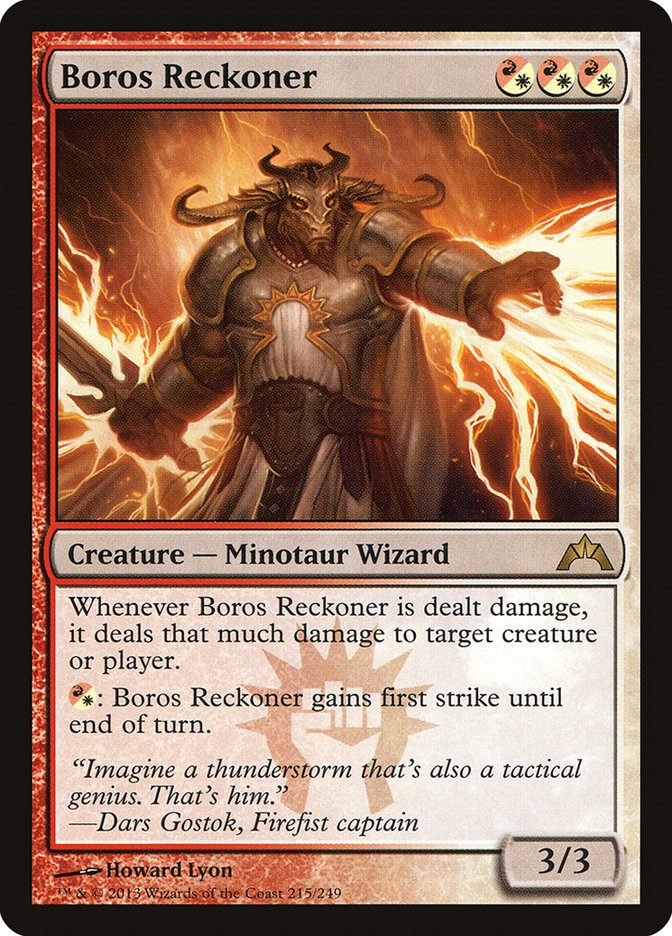Let me begin by saying that the current Standard format is, in my opinion, the best Standard format that I have ever played. There are so many different
and competitive decks floating around that a player ought to never be bored for options of potential decks available to play. I have been playing Standard
in tournaments for well over a decade, and I have never in that time felt that there were literally ten different viable decks that I could sleeve up and
battle with on any given day.
All in all, I believe that things being the way that they are (with so many good cards and so many viable strategies) is a huge vote of confidence in the
job that R&D has done with the development of the game and new sets. If WOTC continues to produce such a quality product for its players to enjoy, I
see no reason why Magic shouldn’t continue to grow and become even more popular in the coming years!
With that being said, it’s important to also realize that while there are a lot of options available in Standard, there are also pillars/constraints on the
format.
The Fun Police.
My viewpoint on Standard is that these two cards and the respective decks that they empower are the defining limits of the current Standard metagame and
that all decks must address these strategies in one form or another. Over the course of the past year, various Mono-Black Devotion and U/W Control variants
have proven time and time again to be the most consistent performers in Standard.
I have been watching a ton of Magic on the web the past few weeks as well as testing out various decks and match ups, and that experience has led me to
several realizations about how the Standard format works. I was able to watch every single game of the Pro Tour Top 8 and it really drove home one very
important point to me: creating leverage and using that advantage to force through victories is the way in which Standard works.
Now, that may seem intuitive enough to most players. If you get ahead and stay ahead that it is a recipe that translates into victory. And yet, whether
players consciously live by this mantra or not, how does a player get ahead and stay ahead in a format where everybody is trying to play from the front
foot?
The fabled “come from behind” out of nowhere victory is the exception and not the rule in this format, and the advantages that can be pushed or leveraged
from ahead quickly become insurmountable in Standard. Standard is fast and unforgiving and accepting this fact is the first step toward upping one’s win
percentage in whatever tournament they are trying to win.
FACT #1: STANDARD IS A CREATURE-BASED FORMAT
While there are certainly decks like Jund Planeswalkers and U/W Control that do not crux on creatures to execute the vast majority of their gameplan
throughout the early, mid-, and late game, every deck in the format wins the game by attacking with creatures at some point.
Standard is not like Legacy, Modern, or Vintage where combo decks threaten to Ritual or Reanimate their way to a fast victory. In fact, the non-creature
type decks tend to adopt the control role in most matchups and leverage card and/or resource advantage to create inevitability in the later stages of the
game against a resource-exhausted opponent.
The biggest exception to the rule is Ivan Floch’s Pro Tour winning U/W Control deck list.
Planeswalkers (3)
Lands (26)
Spells (31)
- 2 Last Breath
- 2 Syncopate
- 4 Quicken
- 3 Divination
- 3 Planar Cleansing
- 1 Elixir of Immortality
- 4 Azorius Charm
- 4 Supreme Verdict
- 4 Sphinx's Revelation
- 4 Dissolve
Sideboard

WHAT DOES IT LEVERAGE:
– Card advantage and lifegain.
– Mana advantage. Because of the ability to draw so many cards, U/W makes more land drops than anybody else which means that as the game goes longer U/W
has a tremendous advantage in available mana, and thus, plays.
– Positional advantage. Quicken goes a long way by allowing U/W to represent sorcery speed sweepers at instant speed. Once U/W gets ahead, it can force the
terms of engagement by forcing opponents to play directly into its answers and make multiple plays per turn because of its advantage in mana.
– A nigh unbeatable endgame of infinite card draw via Elixir of Immortality and Sphinx’s Revelation.
BEST THINGS TO LEVERAGE AGAINST U/W:
– One-drop creatures. Fast, recurring sources of damage that U/W can’t trade profitably with early in the game. Although the printing of Nyx-Fleece Ram has
drastically improved these types of matchups. The best way to beat U/W is to kill them before they can leverage their big gun, Sphinx’s Revelation.
– Hand disruption backed up by recurring sources of damage, card draw, or planeswalkers. U/W does not actually create a board presence via
creatures/blockers. Stripping a U/W player’s hand of answers to a threat and leveraging that threat can go a long way toward getting ahead, staying ahead,
and winning.
– Slaughter Games naming Sphinx’s Revelation.
First, let me say that from the perspective of a guy who has built and piloted many a control deck in his day that Floch’s U/W Control is an absolute work
of art. Everything in the deck works toward achieving one singular, powerful strategy that culminates in the biggest endgame of any deck in the format: the
ability to draw through one’s deck multiple times, gain an insurmountable amount of life, and kill everything on the board at instant speed with impunity
and counterspell back up.
FACT#2: STANDARD IS COMPOSED PRIMARILY OF LINEAR DECKS
While most of the time player’s use the term “linear deck” to refer to combo decks that have but one way to win (think Dredge or Belcher in Legacy), I’ve
found this comparison extremely helpful when assessing how the majority of Standard decks try to interact with their opponents.
Floch’s U/W Control list is linear in the scope of what it is trying to accomplish and how it goes about executing this gameplan. The objective is to play
a land every single turn, to keep the board clear of opposing permanents, and then to out draw and out lifegain an opponent in such a way that it becomes
impossible for the opponent to actually win the game.
Ivan’s deck has one singular gameplan through which victory is achieved, and that plan is “to not die,” because if he does not die, he will inevitably win
the game simply by getting so far ahead of the opponent.
I want to live forever.
I started with Ivan’s U/W Control deck because on a spectrum of the decks that are played successfully in Standard, it is very clearly the marking post on
one far end of the format. Ivan’s deck wins through pure defense, lifegain, card draw, and by outlasting opponents. Once the window for an opponent to kill
U/W runs out, the door closes and does not reopen, as U/W simply starts to get “turns ahead” by leveraging counterspells, removal, and card draw in hand to
create a scenario where even if an opponent were to draw the best possible card three-four-or-five turns in a row, the U/W player would already be able to
answer these threats while continuing to push life total, card, and mana advantage with Sphinx’s Revelation.
So, I have made the claim that Standard is a creature based format and featured a U/W Control deck that basically plays no creatures…
While U/W Control may function as the exception to the rule with regard to what it does, the construction and objective of this deck plays very
much into the rule as I have proposed it.
U/W Control is constructed on the predication that all of its opponents will be playing creature-based decks, and as such, it is jam packed with cards that
answer creatures in a profitable manner. U/W Control is all removal, board sweepers, card draw, lifegain, and an Elixir of Immortality and is very
efficient at destroying opposing creatures.
FACT #3: THE DEVOTION MECHANIC IS FORMAT DEFINING
Linear, creature-based, devotion decks make up a large chunk of the Standard metagame.
Creatures (28)
- 4 Judge's Familiar
- 4 Frostburn Weird
- 4 Cloudfin Raptor
- 4 Nightveil Specter
- 4 Tidebinder Mage
- 4 Thassa, God of the Sea
- 4 Master of Waves
Lands (25)
Spells (7)
Sideboard

WHAT DOES IT LEVERAGE:
1. Fast board presence that enables powerful Devotion-based bombs, i.e. Thassa, God of the Sea, Master of Waves.
2. Recurring, evasive sources of damage, both fliers and Thassa’s “unblockable” ability.
3. Tempo. One-drop, two-drop, three-drop curves that get ahead and continue to get further ahead.
WHAT TO LEVERAGE AGAINST IT:
1. Attack their pieces with removal. Mono-Blue relies heavily upon the synergy between its cards. Individually, many of Mono-Blue’s cards are not highly
impactful and therefore removing a few pieces with removal can leave their board presence looking severely underwhelming.
2. Sweepers. Mono-Blue is a creature-based aggro deck, and thus, is vulnerable to having all their pieces swept away.
Mono-Blue Devotion has been a mainstay on the constructed Standard circuit ever since it dominated the format at Pro Tour Theros.
Two years ago I would have scoffed at a deck that played Cloudfin Raptors, Judge’s Familiars, and Frostborn Weirds in order to power up exceptional threats
like Master of Waves and Thassa, God of the Sea.
Then I learned something that changed my life and perspective on Magic decks forever.
Mono Blue is the Affinity of Standard.
There are some cards in some strategies that are worth playing with individually weaker cards in order to enable them. For instance, I remember saying
dozens of times, “I can’t even imagine living in a world where I would sleeve up an Ornithopter!”
Mono-Blue Devotion may play some Ornithopter-esque cards, but the pay off via big-time trumps like Master of Waves and Thassa, God of the Sea makes it
happen. In actuality, the similarities between Affinity and Mono-Blue Devotion are pretty huge. Both quickly establish a board presence that enables super
powerful, undercosted cards to leverage these quick advantages into fast victories. Both decks also take advantage of playing evasive flying creatures that
can largely ignore the majority of potential blockers to continue to squeak damage through.
Another deck that is in a similar category to Mono-Blue is Mono-Green Devotion. There is also something to be said with all of these aggressive devotion
decks that only playing one color of mana drastically reduces the risk of getting color screwed. So, while devoting increases the power of one’s synergies
and draws, it also improves consistency with regard to one’s draws. It’s really a win/win for players.
Creatures (27)
- 1 Hornet Queen
- 1 Scavenging Ooze
- 4 Burning-Tree Emissary
- 1 Sylvan Primordial
- 4 Elvish Mystic
- 4 Polukranos, World Eater
- 1 Nylea, God of the Hunt
- 1 Arbor Colossus
- 4 Voyaging Satyr
- 3 Courser of Kruphix
- 2 Genesis Hydra
- 1 Reclamation Sage
Planeswalkers (5)
Lands (24)
Spells (4)

WHAT IT LEVERAGES:
1. An unbeatable goldfish. With Mono-Green Devotion, an opponent must interact in some way, shape, or form. If the opponent does not or cannot, they will
enviably lose because Green goes bigger and faster than anybody else can on the fourth, fifth, and sixth turns.
2. Mana Advantage. There is no deck better at exploiting Nykthos, Shrine to Nyx in Standard. The deck can easily make ten-plus mana and has plenty of
powerful things to sink that mana into. Mono-Green also has lots of mana acceleration to start making multiple plays per turn faster than opposing decks as
well as powering out bigger threats more quickly.
3. Board presence. Mono-Green puts a lot of fat permanents into play and is very good at creating an overwhelming board presence that not many decks can
compete with punch for punch.
WHAT TO LEVERAGE AGAINST IT:
1. Interaction with their permanents and devotion count. Just like with Mono-Blue, attacking Green’s in-play resources goes a long way toward forcing them
to stumble. While the burden is on the opponent to interact, the fact is that interacting with their stuff is really awkward for the devotion deck.
2. Sweepers are huge against this deck, and there isn’t a ton that they can do about it besides from simply start over again. A Supreme Verdict not only
robs Green of their threats but also severely stunts their ability to cast their quality threats since it takes Nykthos and mana creatures out of the
equation.
Mono-Green Devotion is the ramp-combo deck of Standard, and if you want to make a lot of mana and do a lot of big time stuff with that mana, this is
probably the deck for you.
No deck in the format has a non-interactive goldfish draw that can hang with Mono-Green. The Green deck will just make twelve mana on turn 4 and put 25
power on the board. The deck is extremely efficient at defeating the opposing aggro decks that have become popular in Standard after the recent PT as they
can present endless threats, gain tons of life via Nylea’s Disciple, and simply out board presence anybody who is trying to put cards into play and attack.
With that being said, Mono-Green is extremely vulnerable to opponent’s whose decks are good at interacting with their board on a profound scale.
Sweeps Weak.
Sweepers are extremely devastating for Mono-Green as they set them back to square one and also take away their explosive ability to produce big mana.
Unlike previous incarnations of the Green Ramp-Combo deck this one is reliant upon mana dorks and not Rampant Growth effects to go high on the curve which
makes it less resilient to removal.
FACT #4: MIDRANGE IS ACTUALLY GOOD
I don’t typically like or advocate midrange decks (as I tend to find the strategy to be a major trap), but it looks like in the current metagame we have
arrived at a Rock-Scissors-Paper moment where all three options are equally fine to throw.
With so many mono-colored devotion decks floating around and trying to gold fish their ways to synergistic victories, it’s no surprise that removal-heavy
good stuff decks have made their presence known.
Mono-Black Devotion variants have been a mainstay of Standard since PT Theros and are not going anywhere for the time being.
The best on the play opening in Standard.
Anybody with a high degree of familiarity with Standard knows to fear the dreaded Pack Rat start from these Black decks.
Creatures (16)
Lands (25)
Spells (19)
- 1 Duress
- 4 Thoughtseize
- 2 Sign in Blood
- 3 Underworld Connections
- 4 Devour Flesh
- 3 Hero's Downfall
- 2 Bile Blight
Sideboard

WHAT IT LEVERAGES:
1. A very potent ability to interact with an opponent’s cards in play via hand disruption, lots of removal, and creatures that create a solid board
presence.
2. Flexibility. Black decks can do a little bit of everything with a high degree of efficiency, whether that’s killing permanents, presenting threats,
plucking away cards with Thoughtseize, or gaining life–Black decks can attack and interact with opponents from basically every possible angle.
WHAT TO LEVERAGE AGAINST BLACK DEVOTION:
1. Tempo and mana are probably the number one ways to fight against Mono-Black. While their cards are flexible and interactive they are limited by their
ability to produce mana and only being able to play one card per turn for the first several turns of the game. Getting out ahead and not allowing a black
mage to line up their removal profitably goes a long way.
2. Make their cards inefficient. Sort of a sub-point of point one–playing cards in a manner that they cannot answer that efficiently is huge.
3. Play from ahead. Getting ahead of Mono-Black Devotion is the most important element for most decks. When they have lots of time to line up their cards
for value and then play their more expensive trumps, they are going to win a lot of games.
Jund Planeswalkers was one of the big breakout decks of Pro Tour Magic 2015 and interacting with opposing creature based decks is its game.
Creatures (12)
Planeswalkers (11)
Lands (24)
Spells (13)

WHAT IT LEVERAGES:
1. The ability to interact with opposing threats via removal and then going over the top with the recurring advantage of planeswalkers.
2. Card advantage generated by Courser of Kruphix and planeswalkers.
3. Mana advantage and the ability to quickly start making multiple plays in a turn through mana accelerants like Sylvan Caryatid and Elvish Mystic.
WHAT TO LEVERAGE AGAINST JUND PLANESWALKERS
:
1. Counterspells. While the quality of its threats are powerful, the actual threat density of this deck isn’t super high. Jund plays a lot of reactive
cards and mana sources so simply attacking or denying their proactive cards is a big game.
2. Thoughtseize. Hand disruption can stop Jund from deploying its trademark Walkers.
3. Pithing Needle. D’oh!
I like this deck a lot and could actually see myself sleeving it up in a tournament sometime soon.
It is similar to Mono-Black in that it is trying to interact with its opponent and their in-play cards and then move in over the top with more powerful and
card advantage-based threats in planeswalkers.
The biggest drawback that I can see with this deck is that it is possible to have draws that simply don’t do enough to win games. For instance, what does
this deck do if it doesn’t draw its planeswalkers on time? Attack with Courser ten times?
This bomb never mizzes.
Given the resurgence of aggressive creature-based strategies in the face of Sphinx’s Revelation decks, I like the positioning of decks that play a lot of
removal and extremely powerful threats. Mizzium Mortars, in particular, is a card that I’d like to be playing as it matches up extremely well against the
aggressive devotion decks when the overload is accelerated out but is also flexible early on in the game.
Wake me up before you 4/4.
Nissa, Worldwaker is an absolutely awesome Magic card, and every time I’ve watched it hit play on camera in Standard it seems to dominate. The 4/4s even
have trample! What!?
FACT #5: AGGRO IS GOOD
How does one beat Sphinx’s Revelation? Kill them ASAP.
Fast, powerful, threat-heavy decks are typically very good, and this format is no exception.
Not only is aggro abstractly good, but there are also several uniquely different, viable options for the aggro mage.
The first faction of aggro decks that I’d like to feature are the red decks. Specifically, there are two very different ways of building this
hyper-aggressive, all-offense deck; one that is all creature based and another that is primarily spell based.
Creatures (31)
- 2 Ash Zealot
- 4 Rakdos Cackler
- 4 Burning-Tree Emissary
- 3 Legion Loyalist
- 3 Firefist Striker
- 4 Foundry Street Denizen
- 3 Rubblebelt Maaka
- 4 Firedrinker Satyr
- 4 Goblin Rabblemaster
Lands (21)
Spells (8)

WHAT IT LEVERAGES:
1. Speed. The deck has so many one-drops and lots of haste. The goal is to put down recurring sources of damage and use them before an opponent has the
ability to profitably block or rebound.
2. Low mana curve makes your opponent’s cards unable to trade profitably.
WHAT TO LEVERAGE AGAINST IT:
1. Good blockers. G/W creatures, while slower on the aggressive front, tend to be very good at lining up as blockers against mono-red’s creatures.
Fleecemane Lion, Voice of Resurgence, and Loxodon Smiter are a nightmare.
2. Board presence + lifegain. Mono-Green’s ability to create a fast board presence and then chord out a Nylea’s Disciple comes to mind here, as does
Unflinching Courage.
3. Sweepers, especially of the three mana variety, can put down most fast starts before they really get started.
Wrecking the Rabble.
I like this deck a lot, and as far as I can see it has a lot of really positive matchups. In general, I’d rather be aggressive than passive, and Rabble Red
is really good at being aggressive. I also really like the matchup of this deck against U/W Control.
The key here is that trying to trade one-for-one with this deck is always going to be terrible for the removal player because there are very few individual
targets in this deck (Rabblemaster aside) that are really worth the mana it costs to cast a removal spell.
For instance, trying to cast a Hero’s Downfall on an Ash Zealot is not mana efficient at any point in the game, and repeatedly trying to make these
exchanges is going to be a losing effort. A deck like this also tends to match up well against Black decks (barring them drawing Drown in Sorrow) as it can
get out on the front foot and push through damage turn after turn.
The other red deck is similar in function but completely different in execution.
Creatures (9)
Lands (24)
Spells (27)

WHAT IT LEVERAGES:
1. A unique angle of attack. With creature decks being the defining factor of the format lots of decks are simply not equipped to stop somebody from doming
them to death.
2. A fast clock that can ignore removal. Slower decks simply cannot race or interact with this type of deck which leads to a lot of free wins.
WHAT TO LEVERAGE AGAINST
IT:
1. Fast, recurring sources of damage. Other hyper-aggressive creature decks tend to have an advantage against a deck like this since their sources of
damage are repeatable. However, lifegain burn spells like Warleader’s Helix and removal burn spells (Searing Blood) go a long way to even things out.
2. Recurring sources of lifegain. Oh Nyx-Fleece Ram, why are you the best card in Standard? Sphinx’s Revelation is also a big problem for this deck.
3. Counterspells, Duresses, and Sin Collectors. Because a deck like this doesn’t have as many recurring sources of damage, simply stopping their spells on
the stack or before they are cast is a big concern.
R/W Burn approaches the format in a way that is similar to how a Sphinx’s Revelation does, in that it accepts the format is about trading creatures and
removal spells and simply foregoes that rat race for a different linear angle of attack.
Unlike U/W Control, which is all removal, lifegain, and card draw, R/W Burn is a few damage dealing creatures and a lot of big sources of one-time damage
to the face.
THREE FOR FOUR!!!
There are an abnormally high number of good burn spells that simply deal four damage to the face which means that resolving five spells can end the game on
the spot. That is not a bad place for a burn mage to be.
Creatures (23)
- 3 Loxodon Smiter
- 4 Experiment One
- 4 Voice of Resurgence
- 4 Fleecemane Lion
- 3 Boon Satyr
- 3 Soldier of the Pantheon
- 2 Sunblade Elf
Planeswalkers (3)
Lands (24)
Spells (10)
Sideboard

WHAT DOES IT LEVERAGE?
1. Great creatures at bargain basement prices. G/W is full of cheap creatures that have the best possible available stats in the format. 2/2s for one, 3/3s
for two, 4/4s for three, and 5/5s for four. Mana for mana, G/W’s creatures outclass everybody else’s creatures.
2. Tempo and profitable attacks. For the most part G/W decks play creatures and attack an opponent to death. The gameplan is that at every point in the
game, G/W’s creatures will be bigger and stronger than an opponent’s available blockers, and when they aren’t, combat tricks can push them over the top.
WHAT TO LEVERAGE AGAINST
IT:
1. Removal. While G/W goes up the curve with great deals on creatures, efficient removal tends to be very good against a deck like this. Trading two-mana
Doom Blades for three and four cost creatures is a great way to stem the tides.
2. DEVOTE!!! Since G/W doesn’t have a ton of efficient quality removal, it is difficult for this deck to break up synergies between creatures in devotion
decks. Master of Waves, Gray Merchant of Asphodel, and Nykthos can all be problematic and go over the top of vanilla creatures.
3. M14 Hatebears. Lifebane Zombie and Tidebinder Mage have long been the bane of this color combination. Straight up value two-for-ones are a beating.
G/W Aggro is super straightforward: great beats at a great price.
A deck like this is a little bit different than a devotion deck or a red deck because the strategy relies less upon synergies between a combination of
cards and instead has a higher overall power level.
G/W is one of the best decks at leveraging being ahead because its creatures are so good in combat that it often makes blocks for a wide variety of decks a
losing proposition. A high threat density also makes this deck quite strong, as the odds of curving out with consistency are very high.
Creatures (26)
- 4 Dryad Militant
- 2 Precinct Captain
- 4 Ghor-Clan Rampager
- 4 Boros Reckoner
- 4 Voice of Resurgence
- 4 Fleecemane Lion
- 4 Soldier of the Pantheon
Planeswalkers (3)
Lands (22)
Spells (9)

WHAT IT LEVERAGES:
1. A fast clock and tempo game. Lots of one-drops, combat tricks, and a good curve allow Brave Naya to get ahead and stay ahead.
2. High quality creatures. While the creatures may be cheap and efficient, they are also of a very high quality, especially in combat. Boros Reckoner is a
huge game against opposing aggressive strategies that have become popular in recent weeks.
3. Over the top alpha strikes. Brave the Elements allows Naya to simply attack past an army of blockers such as Pack Rats or a horde of devotion creatures.
Having a spell that gives all of your creatures protection from a color in a field defined by mono colored devotion decks is a big game.
WHAT TO LEVERAGE AGAINST
IT:
1. Sweepers, in particular Supreme Verdict. Brave Naya doesn’t have the luxury of Advent of the Wurm and so sweepers tend to be very strong. Also, their
primary protection spell, Brave the Elements, can’t help save their critters.
2. Burn and fast damage. Naya does a lot of damage to itself via its own manabase, which against opposing aggressive decks, can set up non-favorable racing
situations.
3. Removal.*
4. Devotion Synergies.*
I put an asterisk next to points three and four because these things kind of sort of work sometimes against this deck. Brave Naya is an aggro deck, and
thus, you’re trying to get out in front of an opponent and leverage your positional advantage to push through damage, force bad blocks, and go over the top
with combat tricks such as Ghor-Clan Rampager.
While removal and devoting are good against this deck, the effectiveness of these approaches depends wildly upon the context and how much tempo can be
leveraged.
For instance, spending a turn trying to use a removal spell on an important creature only to have that removal shrugged off by a Brave the Elements can
generate enough tempo to create insurmountable board advantage.
I like the Brave Naya deck because it has a lot of angles it can use in order to generate big swings of advantage. It has a lot of powerful spells that can
win the game outright.
OMG, that’s going to be game…
Last but not least in the aggro category is my favorite pet deck: Naya Hexproof.
I actually got a chance to take my favorite Standard deck out for a spin yesterday and won a modest M15 Game day Standard event with it. I still think the
deck is very good and has excellent placement in the current Standard metagame.
Creatures (20)
Lands (21)
Spells (19)

WHAT DOES IT LEVERAGE:
1. An angle of attack that many decks simply cannot address: Hexproof + auras. Many decks simply have no out to a gigantic, first striking, hexproof,
trample, lifelink creature. With all of the targeted removal in the format, Hexproof really takes advantage.
2. Fast combo kills. Ghor-Clan Rampager + Boros Charm on a suited up creature is game over.
WHAT TO LEVERAGE AGAINST
IT:
1. Sweepers. Aside from Boros Charm and Ajani’s Presence, Hexproof has a tough time beating sweeper effects.
2. Edicts. Because Hexproof needs to put auras onto its creatures to execute its plan, edicts such as Devour Flesh, Celestial Flare, and even Aetherspouts
open the deck up to getting two-for-one’d.
3. Enchantment removal is pretty huge against Hexproof; specifically, instant speed removal that comes into play during combat and can lead to profitable
blocks.
4. Burn. Same issue as Brave Naya where the manabase is painful and can lead to getting burned out early. Fortunately for Hexproof, it is helped in aggro
matchups by being able to make gigantic lifelink creatures that win the game all by themselves.
I have written pretty extensively about Naya Hexproof already which you can read here, so I won’t bore you all
with the same old information twice.
I do believe that Hexproof is really well-positioned in the current metagame, and if there were a big tournament tomorrow, I would play this 75, as the
deck has a ton of very easy matches and lots of ways to win even in matchups that I think are the most difficult. For instance, Boros Charm against U/W
Control wins the game usually on the spot.
FACT #6 EVERYTHING IS VIABLE IN STANDARD
The cool thing about Standard right now is that there are a ton of different decks that do completely different things and attack an opponent from a
variety of angles and they are all justifiably playable decks.
While there are matchups that are favorable or unfavorable, none of these matchups are super great or super terrible. It is much more important from game
to game whether or not a pilot is able to line up their spells properly and create scenarios and board states where they can leverage advantages into
profitable plays and victories.
It’s a really fun time to be a fan of Magic and of Standard, as there are so many different options, decks, and cards to play within the current metagame.
Also, because of how close most of the matchups tend to be, I don’t think that there has every been a time in Standard when making good plays and
understanding what is important from game to game and match to match has ever been so crucial.
One thing is for certain: in this Standard metagame, no matter what strategy you decide to play–aggro, midrange, or control–if you know your deck inside
and out and how to leverage the things that are important from matchup to matchup, your deck will give you some love and pay you off for it.

